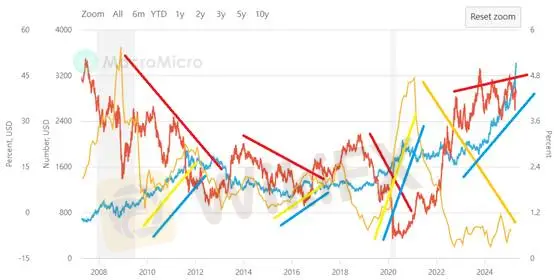简体中文
繁體中文
English
Pусский
日本語
ภาษาไทย
Tiếng Việt
Bahasa Indonesia
Español
हिन्दी
Filippiiniläinen
Français
Deutsch
Português
Türkçe
한국어
العربية
Front-Loading and Stockpiling: U.S. Growth Outlook Remains Firm in H1 2025
Zusammenfassung:Current market volatility is being driven by sentiment-based trading around Donald Trump. Investors are struggling to form expectations, triggering a broad-based sell-off across asset classes and the
Current market volatility is being driven by sentiment-based trading around Donald Trump. Investors are struggling to form expectations, triggering a broad-based sell-off across asset classes and the U.S. dollar. This market dislocation has distorted sentiment, but investing is not about the present moment—once rationality returns, fundamentals will once again prevail. Lets be clear: there are no negative catalysts expected in Q2.
Gold briefly surged toward the $3,500/oz level yesterday before sharply reversing course. Throughout our livestreams, reports, and investor discussions, weve consistently warned that gold is a crowded trade—avoid the herd.
Much of the inflow into gold is being driven by concerns over economic stagnation and a weaker dollar. The persistent risk-off sentiment continues to elevate gold prices. But remember this market adage: when it‘s crowded, it’s time to get out.
Major investment banks have raised their gold targets, but true macroeconomic analysts will tell you that gold has decoupled from fundamentals since 2022. So whats the logic behind these revised targets?

(Chart 1: Blue – Gold Futures, Yellow – YoY Central Bank Balance Sheets, Red – U.S. 10Y Yield)
Historically, gold has moved in tandem with:
YoY growth in global central bank balance sheets (i.e., money supply);
The nominal yield on U.S. 10-year Treasuries.
2022: Stagflation fears pushed gold higher.
2023: Central banks increased gold reserves, driving the bull run.
2024: Geopolitical tensions destabilized the dollar-based system, prompting further reserve diversification.
2025: Renewed recession risks and Trumps tariff policies triggered a massive squeeze in both spot and futures gold markets. U.S.-China trade tensions have again become a major bullish catalyst.
(Chart 2: PCE Downward Revision; Source: Atlanta Fed)
Consumer confidence deterioration: Elevated inflation and high interest rates have dampened outlooks and spending.
Real income pressure: Wage growth hasnt kept up with inflation, eroding disposable income.
Rising prices and borrowing costs: Inflation persists in key categories, limiting discretionary spending.
Fed tightening effect: High interest rates have curbed auto and home loans, delaying large purchases.
Debt burden: Higher rates have increased consumer debt service costs, particularly on credit cards.
(Chart 3: PCE Revised as Low as -0.4%; Source: Atlanta Fed)
(Chart 4: March Retail Sales Lift PCE Back to 0.91%; Source: Atlanta Fed)
Short-term bias: Bearish
Key support levels: $3,313 / $3,198
Key resistance levels: $3,384 / $3,406 / $3,499
Stop-loss: $25 range
Strategy: Favor short positions on intraday rallies
When yields are falling and liquidity is increasing, gold prices typically rise. Thats the traditional macro setup.
Thus, gold moves positively with money supply and negatively with Treasury yields. However, this pattern broke down after inflation surged in 2022:
Gold has already gained over 40% this year, but price and value have diverged significantly. The tariff-driven squeeze early this year pushed U.S. gold imports sharply higher, causing the Atlanta Fed GDPNow model to project negative GDP growth and revise down PCE (Personal Consumption Expenditures) to just 0.66.

As shown, by February 28, 2025, PCEs contribution to GDP dropped into negative territory. This implies weakening consumer support for economic growth.
Key Factors Behind the Consumption Slump:

After Trump's 90-day tariff waiver, PCE was slashed to -0.40, with Q1 GDP revised down to -3.7%, fueling further recession fears and boosting gold.
Yet as of March, U.S. retail sales data began to reflect underlying economic resilience. PCE rebounded to 0.91%, alleviating panic. The price movements, however, still dont align with fundamentals. The early-buying and stockpiling effect is sustaining consumption, as seen in the sharp drop in net exports to -4.91.

Trump‘s 90-day tariff exemption has spurred early household purchases and corporate inventory buildup. Once sentiment normalizes, we expect risk assets to stage a strong rebound, while safe-haven flows retreat. The Fed’s exit from QT and the anticipated rate cuts will set the stage for a classic buy-the-rumor, trap-the-chasers, sell-the-news cycle in gold.
Gold Technical Outlook
Gold has formed a head-and-shoulders reversal pattern, encountering resistance at the Fibonacci 38.5% level ($3,384). Yesterdays bearish candle suggests continued downside risk today. We expect further pullback.
Risk Disclaimer: The views, analysis, and market commentary provided herein are for informational purposes only and do not represent the official position of this platform. All investments carry risk—please trade with caution.
Haftungsausschluss:
Die Ansichten in diesem Artikel stellen nur die persönlichen Ansichten des Autors dar und stellen keine Anlageberatung der Plattform dar. Diese Plattform übernimmt keine Garantie für die Richtigkeit, Vollständigkeit und Aktualität der Artikelinformationen und haftet auch nicht für Verluste, die durch die Nutzung oder das Vertrauen der Artikelinformationen verursacht werden.
WikiFX-Broker
Aktuelle Nachrichten
Lohnt sich die Netflix-Aktie?
Er gehört zu den reichsten Menschen der Welt – und teilt seinen wertvollsten Rat
Die Freenow-Übernahme durch Lyft ist eine Bankrotterklärung der Autokonzerne
Kaufanreiz für BYD, Tesla und Co.: Verband der Automobilindustrie fordert Klarheit bei E-Auto-Prämie von Union und SPD
Millionen für die Expansion nach Amerika: Pliant bekommt 35 Millionen Euro von neuen und bestehenden Investoren
Krass: Dieses Gemüse ist plötzlich viel teurer geworden – esst ihr es noch?
Warum es Deutschland schadet, dass kaum Abgeordnete Unternehmer sind
„Abschwung des US-Dollars beginnt: Euro kann auf 1,30 Dollar steigen, sagt die Deutsche Bank
Wechselkursberechnung


